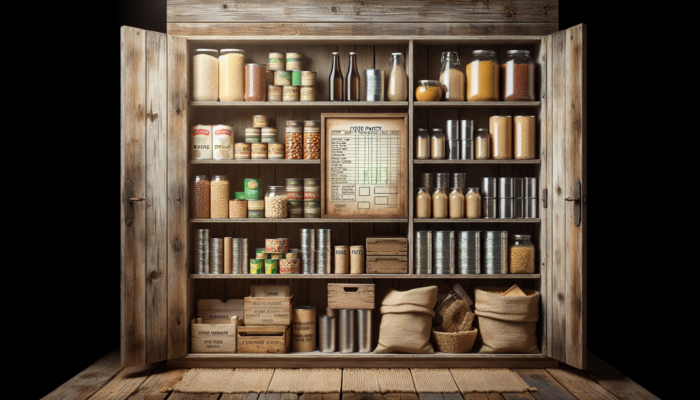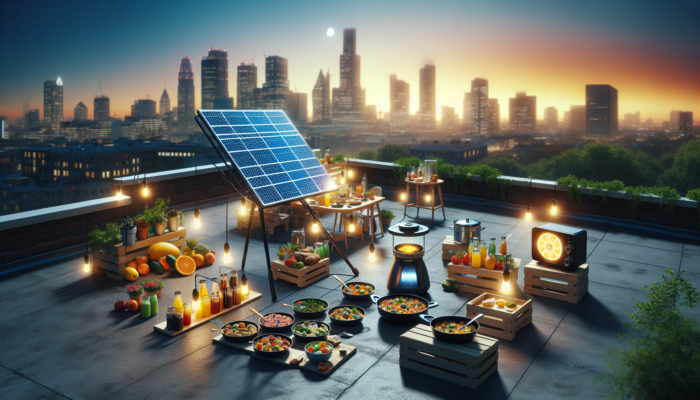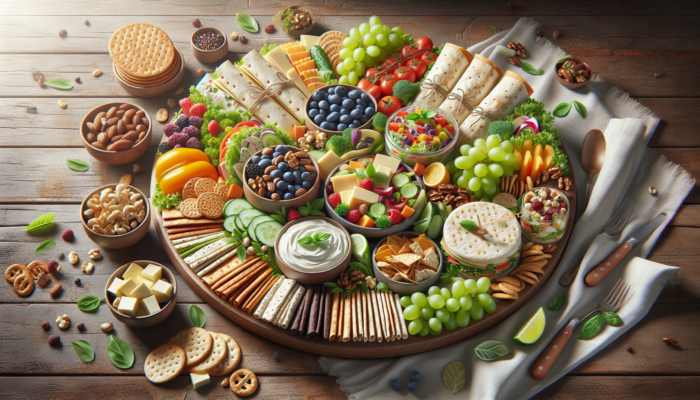Transform Your Kitchen for Effective Blackout Cooking in Urban Areas
During unexpected power outages, your kitchen becomes a crucial hub for survival, transforming itself into a vital resource for your family's needs. The key to mastering blackout cooking in urban environments lies in meticulous preparation and resourcefulness. By equipping your kitchen with essential tools and provisions, you can creatively navigate power disruptions, ensuring that your family remains nourished and comfortable, even in trying times. This detailed guide will walk you through the essential steps required to prepare for such events, guaranteeing that your loved ones are well-fed and at ease, no matter the circumstances.
Build a Robust Stockpile of Non-Perishable Foods for Emergency Situations

In the realm of blackout cooking in urban settings, non-perishable foods emerge as your most reliable allies. These essential items have the remarkable ability to remain edible for extended periods without refrigeration, making them ideal for unforeseen emergencies. Start by thoroughly assessing your pantry to ensure it is well-stocked with vital staples such as canned goods, dried fruits, and grains. Items like canned vegetables, beans, and soup not only provide necessary nutrition but also offer impressive versatility for meal creation.
Additionally, consider incorporating pasta, which can be quickly prepared with just boiling water, and nut butters, which serve as excellent quick snacks when paired with crackers or bread. Don’t underestimate the power of spices and condiments; these can elevate even the simplest of meals, transforming them into delightful culinary experiences. A well-stocked pantry guarantees that you can prepare a variety of meals effortlessly, while also boosting morale during challenging times.
Implement Effective Water Storage Solutions for Cooking and Hydration
Water stands out as the most indispensable resource in any survival scenario, particularly during a blackout. Ensuring a dependable supply of water for both cooking and drinking is crucial for maintaining the health and well-being of your household. Start by storing clean water in food-grade containers, which can be easily labeled and stored in a cool, dark area. A helpful guideline is to have at least one gallon of water per person per day for a minimum of three days, ensuring that your family is adequately prepared for any situation.
Furthermore, knowing water purification methods is essential in a survival context. If your tap water becomes unavailable or questionable, consider investing in a water filtration system or purification tablets to guarantee safe drinking water. Boiling water is another effective purification technique, so ensure you have a reliable method for generating heat. Additionally, collecting rainwater can serve as a sustainable solution, provided you establish the proper systems to ensure cleanliness and safety for consumption.
Essential Cooking Utensils to Prepare Your Kitchen for Blackout Scenarios
Equipping your kitchen with the appropriate cooking utensils can significantly enhance your experience during a blackout. Key tools to consider include a manual can opener for easy access to your canned goods and portable stoves that run on propane or butane. A basic camping stove can dramatically expand your cooking capabilities, allowing for efficient meal preparation even without electricity.
It’s important to recognize the significance of basic kitchen essentials: having a dependable knife, a sturdy cutting board, and various cooking pots are critical for successful meal preparation. Moreover, contemplate investing in a portable grill or a solar cooker for outdoor cooking alternatives when necessary. A reliable flashlight or headlamp will also prove invaluable in illuminating your workspace. By ensuring these essential tools are readily available, you not only streamline the cooking process but also enhance safety and efficiency during an outage.
Discover Creative Cooking Methods to Thrive During Urban Blackouts

When the lights go out, creativity becomes the cornerstone of blackout cooking in urban areas. Embrace innovative techniques that enable you to prepare meals that not only nourish but also inspire. From using solar cooking to crafting no-cook meals, here are some resourceful methods to consider during power outages.
Harnessing Solar Energy for Sustainable Meal Preparation
Utilizing the sun’s energy for cooking presents an ingenious solution during blackouts. Solar cookers come in varied designs, employing reflective materials to concentrate sunlight and generate sufficient heat for cooking. These cookers can effectively bake, boil, and steam a diverse array of foods, making them an eco-friendly option for urban dwellers looking to adopt sustainable practices.
To begin solar cooking, position your solar cooker in a location that receives ample sunlight and adjust its angle throughout the day to maximize exposure. Foods such as rice, beans, and assorted vegetables can be easily cooked using solar ovens, usually requiring minimal supervision. This approach not only promotes sustainability but also allows you to enjoy the outdoors while creating delightful meals, adding an enjoyable twist to your blackout cooking experience.
Safe Outdoor Cooking Methods for Urban Campfires
Cooking over an open flame may seem daunting in an urban environment, but with the right precautions, it can be performed safely and effectively. Setting up a small campfire in a controlled outdoor space, such as a backyard or balcony with proper ventilation, can be a delightful way to prepare meals while soaking in fresh air.
Ensure you have a fire pit or grill to contain the flames and prevent accidents. Utilize dry wood or charcoal to maintain a consistent heat source for cooking. Essential tools for campfire cooking include skewers, cast iron pans, and grill grates. Simple recipes like roasted vegetables, skewered meats, or foil-wrapped meals can turn your blackout experience into a memorable culinary adventure, creating cherished moments with family and friends.
Effortless and Delicious No-Cook Meal Ideas for Quick Solutions

Not every meal during a blackout needs to involve cooking. In fact, there is a plethora of delicious and nutritious no-cook meals that can be prepared quickly and effortlessly. Consider salads made with canned beans, assorted vegetables, and a drizzle of olive oil or vinegar for added flavor. Wraps filled with tortillas, deli meats, cheeses, and fresh veggies can also be very satisfying, offering variety without the need for cooking.
Snack platters provide a fun way to enjoy a variety of foods without any cooking involved—think about an assortment of nuts, cheese, crackers, and fruits. These meals not only save time but also conserve energy resources, making them the perfect choice during power outages. By focusing on no-cook options, you ensure that your family remains well-fed and satisfied without the added stress of traditional cooking methods, fostering a positive atmosphere during challenging times.
Prioritizing Safety in Your Urban Blackout Cooking Practices
Safety must always be a primary concern when engaging in blackout cooking in urban settings. Recognizing potential hazards and understanding how to mitigate them is essential for ensuring a secure cooking experience during power outages. Here are some key considerations to keep in mind.
Ensuring Food Safety During Power Outages
Maintaining food safety during a blackout can be quite challenging, yet it is crucial for preventing foodborne illnesses. Without refrigeration, perishable items can spoil rapidly. The USDA advises keeping your refrigerator and freezer doors shut as much as possible. A fully stocked freezer can preserve food safety for approximately 48 hours, while a half-full freezer might only last about 24 hours.
If you suspect that food has spoiled, trust your instincts—when in doubt, discard it. Look for signs of spoilage, such as off odors, unusual colors, or altered textures. It’s also wise to have a thermometer on hand to monitor food temperatures during outages, ensuring any potentially hazardous food items are disposed of before they become a health risk to your family.
Avoiding Carbon Monoxide Poisoning While Cooking Indoors
Using certain cooking fuels indoors can lead to dangerous accumulations of carbon monoxide, a colorless and odorless gas that can be deadly, particularly in poorly ventilated spaces. If you opt for propane or kerosene stoves, always ensure you are cooking in an outdoor location or have adequate ventilation to prevent health risks.
Investing in a battery-operated carbon monoxide detector can provide peace of mind while cooking. Additionally, familiarize yourself with the symptoms of carbon monoxide poisoning, which may include dizziness, confusion, or headaches. If you suspect exposure, seek fresh air immediately and contact emergency services for assistance.
Implementing Fire Safety Protocols During Cooking
Cooking without electricity can heighten the risk of fire hazards. To minimize these risks, keep flammable materials away from heat sources, and always have a fire extinguisher readily accessible. If you’re using an outdoor grill or campfire setup, ensure that the area is free from debris and any flammable items to prevent accidents.
Practice safe cooking techniques by avoiding loose clothing and securing long hair to avert accidental ignition. Furthermore, it’s crucial never to leave cooking food unattended, especially when using open flames. In case of an emergency, be aware of your escape routes and keep a charged phone nearby for quick access to emergency services if needed.
Involving Families in Urban Blackout Cooking: Keeping Spirits High and Tummies Full
Engaging your entire family in blackout cooking in urban settings can turn a potentially stressful situation into a cherished bonding experience. By preparing meals together and ensuring everyone feels included, you can maintain a positive atmosphere during power outages, making the experience enjoyable for all.
Creating Kid-Friendly Meals to Make Blackout Cooking Enjoyable
When the power goes out, it’s vital to have meals that cater to children’s tastes. Consider simple, fun options that can engage kids in the cooking process. For instance, sandwiches made with their favorite spreads and toppings can be a massive hit among children. Including sliced fruits and vegetables adds a nutritious touch that parents will appreciate.
Another engaging idea is to establish a “build-your-own” pizza station using pre-made dough or tortillas, allowing children to personalize their toppings and create unique pizzas. Ice cream or yogurt parfaits can serve as delightful desserts, even without refrigeration for a short duration. By keeping meals appealing and interactive, you can ensure that even amidst a blackout, everyone remains well-fed and happy.
Encouraging Kids to Be Active Participants in Blackout Cooking Activities
Involving children in the cooking process can transform a blackout into a memorable family event. Assign them age-appropriate tasks, such as washing vegetables, assembling sandwiches, or stirring ingredients. This not only imparts valuable cooking skills but also fosters a sense of responsibility and teamwork within the family.
Consider developing a cooking game where kids can suggest ingredients or meal ideas based on what’s available in your pantry. This encourages creativity and helps them appreciate the importance of resourcefulness during emergencies. By making cooking a fun and collaborative effort, you create lasting memories while ensuring everyone is engaged in the meal preparation process.
Managing Food Allergies During Blackouts for Safe Meal Preparation
Food allergies can present challenges during a blackout, but with careful planning, it is possible to accommodate dietary restrictions effectively. Start by identifying safe options from your emergency stockpile. For instance, gluten-free pasta or nut-free snacks can be crucial for families with specific dietary needs, ensuring they remain safe and healthy.
Consider meal-prepping allergy-friendly recipes ahead of time and storing them in your pantry. This could include easy-to-assemble meals that are free from allergens. Clear communication with your family about food choices and ensuring everyone understands what’s safe to consume can alleviate stress and help maintain health during an outage.
Learning from Real-Life Experiences in Urban Blackout Cooking
Gaining insights from the experiences of others can be invaluable for enhancing your understanding of blackout cooking in urban settings. By examining case studies and personal narratives, you can better prepare for potential challenges and devise effective solutions for your own cooking strategies.
Reviewing Case Studies of Urban Blackouts and Community Resilience
Cities worldwide have faced prolonged power outages due to natural disasters or infrastructure failures. For example, during Hurricane Sandy, residents of New York City adapted by utilizing rooftop grills and communal cooking methods in shared spaces. These case studies underscore the significance of community and creativity in overcoming challenges, illustrating how neighbors can come together to share resources.
By analyzing these real-life scenarios, you can draw inspiration for your preparedness plans. Reflect on how communal resources were utilized and which cooking methods proved to be the most effective during these events. This knowledge empowers you to navigate future blackouts with greater confidence and resilience.
Insights Gained from Interviews with Blackout Survivors
Listening to firsthand accounts from individuals who have navigated blackouts can yield a wealth of practical wisdom. Many survivors emphasize the importance of flexibility and innovation in the kitchen during power outages. One survivor shared how they used a car battery to operate small appliances, enabling them to cook meals and maintain morale during difficult circumstances.
These interviews often highlight the value of community support, as neighbors unite to share resources, ideas, and even meals. By understanding these experiences, you can collect practical tips and inspiration for your own blackout cooking strategies, enhancing your readiness for future events.
Connecting with Community Resources for Support During Outages
Local organizations often provide assistance during extended blackouts by offering resources for food distribution and organizing community cooking events. Establishing connections with these entities can help ensure that you have access to essential supplies and information during emergencies, reinforcing community bonds during challenging times.
Consider reaching out to local community centers or nonprofits focused on disaster preparedness. They may host workshops on emergency cooking, food storage techniques, and even community potlucks to foster connections among residents. Building a network with other families can facilitate the sharing of resources and ideas, ultimately enhancing your collective resilience during a blackout.
Future-Proofing Your Strategies for Urban Blackout Cooking
Preparation is crucial when it comes to blackout cooking in urban environments. By investing in the right resources and developing a comprehensive plan, you can ensure that you’re equipped for any future outages, protecting your family’s health and morale.
Investing in Backup Power Solutions for Your Cooking Needs
Implementing backup power solutions can significantly enhance your cooking capabilities during a blackout. Consider investing in a generator capable of powering essential appliances or a battery-powered cooking device that operates independently of the electric grid, ensuring you can prepare meals even when the electricity is down.
Additionally, solar-powered chargers can keep your devices functional, allowing you to stay updated on the status of outages and recovery efforts. Researching options that align with your lifestyle and budget will empower you to make informed decisions, ensuring that your kitchen remains operational even in challenging circumstances.
Assembling a Comprehensive Blackout Cooking Kit for Preparedness
Creating a thorough blackout cooking kit is a crucial step in ensuring you are ready for any emergency. This kit should encompass non-perishable foods, water storage solutions, and essential cooking utensils. Consider including items like a first-aid kit, flashlights, and a portable stove to guarantee you’re prepared for any situation that may arise.
Be diligent about regularly checking and replenishing your kit, replacing expired items and rotating stock as necessary. Involving your family in this process can help everyone appreciate the importance of preparedness and encourage them to contribute ideas on what should be included in your blackout cooking kit.
Staying Informed During Outages: The Importance of Real-Time Updates
Having access to real-time information during a blackout is vital for safety and preparedness. Consider investing in a battery-powered radio or a hand-crank emergency radio to remain informed about local news and recovery efforts, including updates on power restoration timelines.
Utilize mobile applications that provide alerts and updates regarding power outages in your area. Staying informed enables you to make timely decisions about food management and cooking methods, ensuring that you are always a step ahead during an emergency situation.
Frequently Asked Questions About Blackout Cooking
What are the top non-perishable foods for blackout cooking emergencies?
Canned goods, dried fruits, grains, and pasta are excellent selections due to their long shelf lives and versatility in various recipes, providing essential nutrition during outages.
How should I properly store water for cooking during a blackout?
Store water in food-grade containers and keep it in a cool, dark location. Aim for at least one gallon per person per day for several days of preparedness, ensuring adequate supplies for cooking and hydration.
What cooking utensils are essential for a blackout scenario?
A manual can opener, portable stove, sturdy knives, cutting boards, and various pots are vital tools for efficient cooking without electricity, allowing for versatility and safety.
Is it practical to utilize a solar cooker during a blackout?
Absolutely! Solar cookers harness sunlight to prepare meals and serve as an effective method for sustainable cooking during power outages, enabling you to use natural energy.
What are some kid-friendly meal ideas for cooking during a blackout?
Sandwiches, wraps, and no-cook snack plates featuring fruits, nuts, and cheese are excellent options that keep kids engaged and satisfied, making cooking enjoyable for the entire family.
How can I maintain food safety during a power outage effectively?
Keep refrigerator and freezer doors closed as much as possible, and discard any perishable items that have been above 40°F for more than two hours to prevent foodborne illnesses.
What safety precautions should I take when cooking indoors during a blackout?
Always ensure proper ventilation, avoid using fuels that produce carbon monoxide indoors, and keep flammable materials away from heat sources to minimize risks during cooking.
What should I include in my blackout cooking kit for optimal preparedness?
Your kit should encompass non-perishable food, water storage solutions, essential cooking utensils, a first-aid kit, and emergency lighting supplies to ensure you are well-prepared.
How can I involve my children in blackout cooking activities to make it fun?
Assign them age-appropriate tasks, encourage their meal ideas, and make the cooking process enjoyable and interactive to foster creativity and engagement during power outages.
Where can I find community support during a blackout situation?
Local organizations and community centers frequently provide resources and workshops on disaster preparedness and can assist with food distribution, creating a supportive environment during outages.
The post Blackout Cooking: Your Essential Survival Guide appeared first on Survival Bite.
The Article Survival Guide for Blackout Cooking Essentials Was Found On https://limitsofstrategy.com
The Article Blackout Cooking Essentials: Your Survival Guide First Appeared ON
: https://ad4sc.com


This discussion on blackout cooking resonates deeply with the rising need for self-sufficiency in urban areas, especially as power outages become more frequent due to various issues like extreme weather events and infrastructure strain. The emphasis on preparing a stockpile of non-perishable foods highlights an often-overlooked aspect of urban living—our dependence on convenience and technology can leave us vulnerable during disruptions.